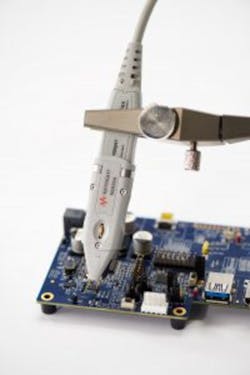Keysight introduces browser head for InfiniiMax II probes
Santa Rosa, CA. Keysight Technologies has introduced the N2839A differential browser head for use with InfiniiMax I/II Series probe amps, bringing the measurement fidelity of a solder-in probe head to hand-held browsing. When used with the InfiniiMax II 1169A probe amplifier, the N2839A gives users 12 GHz of bandwidth, making this the world’s most usable hand-held browser solution for measuring high-speed differential or single-ended signals.
The spring-loaded probe tips of the N2839A ensure a secure connection to the DUT. The probe tips can be adjusted to accommodate targets from 0 mm to 3 mm apart using the thumbwheel and can be easily and quickly replaced if accidental damage occurs. The low-inductance ground spring ensures that the probe’s frequency response remains constant regardless of the span range setting.Unlike conventional probe browsers in this class, the N2839A provides extremely low probe loading. As the signal speed increases, the capacitance element of the probe’s input becomes a dominant factor in determining the amount of probe loading. The larger the input capacitances, the more the probe may load the DUT or affect the response of the measurement when the measured frequency increases. The N2839A provides 0.21 pF of low input capacitance, which is just as low as that of a solder-in head, minimizing the probe effect in measuring high-speed signals.
“Our design goal for the new N2839A browser was to deliver a high-quality, durable, differential browser head that has the signal fidelity of our solder-in probe-heads,” said Dave Cipriani, vice president and general manager of Keysight’s Oscilloscope and Protocol Division. “This combination gives our customers an easy-to-use probe with excellent measurement accuracy.”
The browser head costs $2,700; a browser tip kit costs $150.


